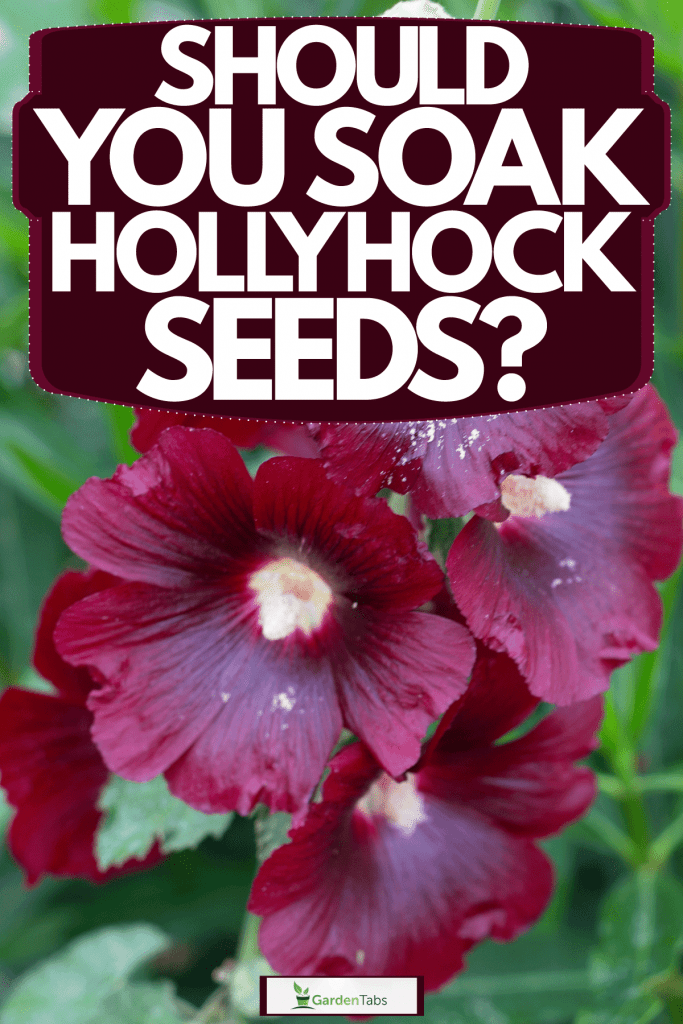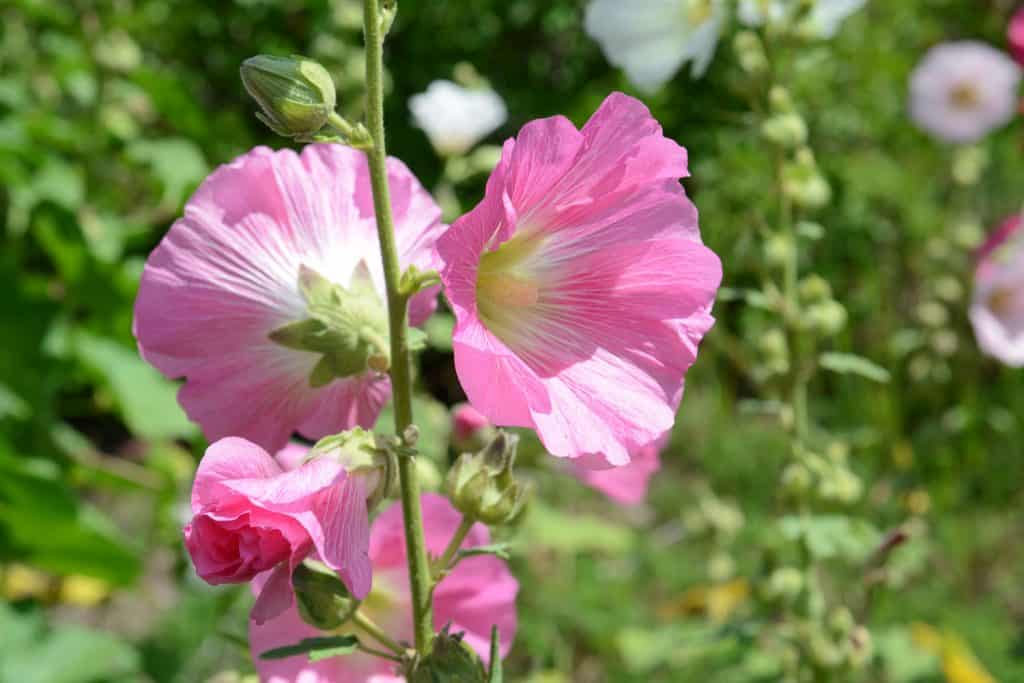Hollyhocks are known as very hardy plants, and they can be grown from seed for both indoor and outdoor planting. If you're growing this plant from seed for the first time, you may wonder whether or not you need to soak them beforehand. We have researched this inquiry, and we'll discuss whether or not it's a good idea to pre-soak these seeds.
It's generally best to pre-soak hollyhock seeds before germinating them. When you soak the seeds in water, it helps to loosen the outermost layer of the seed, which makes it easier for germination. This, in turn, results in quicker germination and an increased likelihood of sprouting.
Hollyhock seeds can be sensitive to light, temperature, and humidity. So be sure to keep them in a safe place before you soak or germinate them. Storing them in a dark tank container or seed bag can help to preserve them before planting. Keep reading to learn more about germinating hollyhock seeds.

Why Soak Hollyhocks Seeds?
As mentioned earlier, soaking your hollyhock seeds can help them germinate faster by loosening up their outer shell. There are different ways that you can do this, but the process is fairly straightforward.
Like other plant seeds, these seeds have an outer shell to protect them from becoming damaged. The shell makes the seeds more impervious to harsh conditions such as dryness, wetness, and extremely cold or hot temperatures.
When you soak the seeds, you also give them a quick boost of moisture that gives them a pre-emptive nudge to begin the germination process--which starts with getting rid of the outer shell. So, if you're looking to speed things up with your germination process, pre-soaking the seeds is definitely a good way to start.

How Do You Germinate Hollyhock Seeds?
Germinating hollyhock seeds is a pretty straightforward process. These seeds prefer to stay in a warm environment of anywhere from 70 to 75 degrees Fahrenheit. They will usually germinate anywhere from 14 to 27 days after they've been planted. If you are planting the seeds outside, you'll want to make sure that you wait and least two to three weeks after the last frost so that the soil is warm enough for the seeds. Let's take a look at the steps to germinate them.
Steps to Germinate Hollyhock Seeds
- Start by taking a small or medium-sized bowl and fill it with warm water. If you have spring water available, this will also suffice.
- After filling the bowl with hot water, toss the seeds inside and let them stay in the water for about 12 to 24 hours. Try not to let the seeds soak for more than 48 hours, as this can hurt their ability to germinate. However, try to monitor the seeds every 4 to 6 hours to monitor their development. If you notice the outer shell of the seeds starting to crack and peel away, note that this is a good sign. You can also take your index finger and thumb and rub the seeds in your fingers if the shells are not completely removed after 24 hours.
- After removing the seeds from the water, pat them dry with a paper towel and follow up with your planting method.
- After the seeds begin to sprout roots, you can plant them.
If you plant them in a container, be sure to cover them with at least 3 inches of soil so that they will not float to the top when you water them. If you are growing the plants inside a greenhouse, or a vegetable patch in your backyard, it's a good idea to first decide on the right location. This way, the seeds will get the sunlight that they need to sprout into baby plants.
Check out this plant pot set on Amazon.
Are Hollyhocks Hard To Grow From Seed?
Not typically. Hollyhocks aren't considered more difficult to grow when compared to other types of indoor plants. Similar to other plants, however, it's best to handle the seeds with care so that the sprouts will not become damaged. This means storing the seeds properly and, in many cases, pre-soaking them to help decrease their germinate time.
The biggest thing you'll want to watch out for when drawing these plants from seed is a fungus, weather changes, and pests. Let's take a look at to keep the plants healthy and thriving.
Common hollyhock diseases
Rust, leaf spots, and other fungal issues can commonly plague hollyhock plants in their early stages if they're not monitored for these issues regularly. Leaf spots may begin with small gray spots on the plants' leaves that eventually develop into larger spots and holes that eat through the foliage.
Leaf rust is a common problem with indoor and outdoor plants. This fungus will cause your hollyhock plant to develop a yellowish powdery residue on its leaves. If the issue is not treated, some of the leaves will eventually die, and the plant can then become more susceptible to other issues.
So it's best to treat leaf rust as soon as possible before the disease has a chance to progress. You can do this with a typical plant fungicide or by using natural remedies.
Check out this fungicide on Amazon.
Typical hollyhock pest infestations
The most common type of pests you'll need to be worried about when it comes to hollyhock plants are Japanese beetles, hollyhock weevils, and sawflies. If you begin to notice small round black, brown, or white dots on the leaves of plants, the chances are that you have a pest infection, and maybe from one of these insects.
Japanese beetles are known for munching on the leaves of hollyhock plants, causing large holes in the leaves--which will make them fall off eventually.
Hollyhock weevils and Japanese beetles will disrupt the life of your plant by laying larvae on the plant's leaves. The larvae will eventually feed on them. This will quickly drain the life from your plant, so it's best to treat the infestation early. You can use insecticide sprays or soaps to get rid of infestations. You can also wash the plant down and rubbing alcohol or neem oil.
Read more details about this insecticide on Amazon.
Protecting hollyhocks from harsh weather conditions
It helps to stay mindful of the conditions in which you place your newly planted seeds. Things such as heavy rain and high wind can quickly damage newly planted hollyhocks, causing them to die before they have a chance to grow and bloom. Even when the plant has reached maturity, the stocks can still be knocked over by a strong wind or thunderstorms.
These plants are fairly hardy, but they are more susceptible to weather damage in their infancy stage, so it's best to keep an eye on them. To do this, you can use a trellis and position it behind the plant to help provide anchoring. Or you can use garden twine to prevent the plant from tipping over during a strong wind.
Check out this garden twine on Amazon.
When Should You Sow Hollyhock Seeds?
The best time to sow hollyhock seeds is before springtime. This is especially true if you are planting the seeds outside, as the ground will be warmer and able to support the seeds. If you are planting the seeds in a pot, it doesn't matter when you sow them as long as they receive proper care, such as sunlight, healthy soil, and a comfortable environment.
This means a temperature of anywhere from 65 to 75 degrees Fahrenheit and well-draining moist soil with a pH of anywhere from 6 to 8. It's a good idea to test the soil bi-weekly or monthly using a pH testing kit.
Check out this pH testing kit on Amazon.
Do Hollyhocks Come Back Every Year?
Yes. Hollyhock plants do come back every year, though they are considered biennial plants. These plants self-seed and typically begin growing again in early July, with beautiful new blooms in August and September.
Do Hollyhocks Spread?
Not much. On average, a hollyhock plant will spread anywhere from 1 to 2 feet wide. However, these plants can reach heights of two 6 to 8 ft tall. Once they are established, you won't have to trim them unless they become too tall, as they generally don't spread that wide. However, if you have them in a small corner or a closed-off location in your home, you may want to take off a few inches every year.
Read more details about these pruning shears on Amazon.
Wrapping Things Up
Hollyhocks grow beautiful flowers in the summer, and overall they make for great indoor and outdoor plants. Overall, you'll find that germinating and planting hollyhocks seeds is fairly simple, though you'll want to take precautions when the plant is in its infancy stages. When growing them straight from seed, it helps to pre-soak them to make for a quicker germinating process
Be sure to check out our other before you go:






